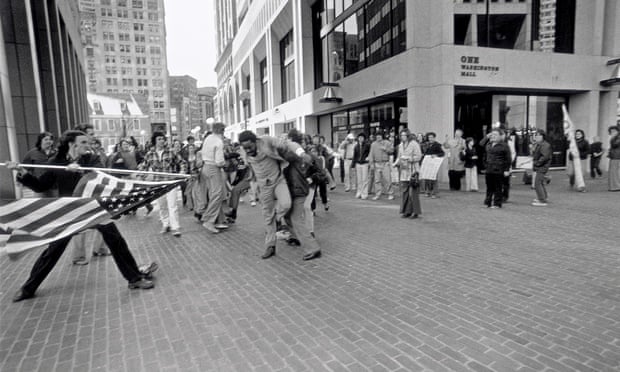December 15, 2025
They all also centered around a single issue: immigration. --click to read full report
Monroe Gallery of Photography specializes in 20th- and 21st-century photojournalism and humanist imagery—images that are embedded in our collective consciousness and which form a shared visual heritage for human society. They set social and political changes in motion, transforming the way we live and think—in a shared medium that is a singular intersectionality of art and journalism. — Sidney and Michelle Monroe
December 15, 2025
They all also centered around a single issue: immigration. --click to read full report
October 10, 2024
ARTIST TALK - Photographer Nina Berman will do a guided tour through her We The People exhibition for an inside look at the protest photographs she has been taking for over thirty years. She will talk about what inspired her to turn her lens on protest in America and what she has learned about the people who organize and assert their right to protest. Sunday, October 20th 2024 @ 4pm. Suggested donation $10.
Click here to RSVP
WE THE PEOPLE: PHOTOGRAPHS BY NINA BERMAN
We the People brings together more than three decades of work by photographer Nina Berman who has tenaciously documented the public outrages, injustices, protestations and longings of a deeply dissatisfied and increasingly polarized society. What the United States should be, and for whom, are questions at the heart of Nina’s work and the 2024 election. September 8th - November 24th, 2024
September 21, 2024
"Photography radically acts as a language that speaks for the world’s oppressed and critically functions as a vital visual voice of resistance."
"Photography helps us understand what we are and imagine what we might become...
The fight for equality across the human condition radically evolves out of protest. Beyond the jackboots, the batons, the water cannon, the tear gas, the bullets, the tanks, the fences, the walls, the concentration camps and all means of surveillance, history teaches that what power fears more than anything is a people on the move against injustice. Looking at the history of photography, we can understand that progress across the political terrain of human rights has been difficult. Marginalized bodies, when divided, are vulnerable to capture, control and genocide. Thinking through our past in photographs and decentering the knowledge formations of imperial lenses means that we can critically join or remake the politics of the left intersectional, aligned in mission, and truly inclusive. This will create waves of solidarity and supportive modes of resistance that strategically enable people to embrace the different ecologies of freedom and resist imperialist politics that divide and rule" -- click for full article
May 1, 2022
The Water Protectors of Standing Rock were the focus of two court actions this week. The North Dakota Supreme Court ruled that 60,000 spy documents of TigerSwan are public records to be released. In a separate court action, Water Protectors injured by rubber bullets and projectiles fired by law enforcement filed an appeal of a class-action civil rights lawsuit. It was earlier thrown out by the court which sided with law enforcement.
By Brenda Norrell
Censored News
Top photo by Ryan Vizzions
The North Dakota Supreme Court ruled that TigerSwan's documents from Standing Rock are public records. Confirming the ruling of the district court, the high court's ruling means that The Intercept and other news media will be able to obtain the documents.
The high court ruled that a state regulatory committee must comb through the 60,000 documents and remove those associated with trade secrets and litigation.
The lawsuit is a victory for free press. Documents that have already been leaked reveal the names of many Water Protectors who were targeted by TigerSwan at Standing Rock. Those leaked documents also expose infiltrators in the camps who attempted to entrap Water Protectors and provoke crimes.
In a separate court action, Water Protectors who were injured by rubber bullets and other projectiles fired by law enforcement filed an appeal of a case that was thrown out by the courts.
"Water Protectors filed an appeal in the Dundon v. Kirchmeier civil rights case. Dundon v. Kirchmeier is a federal civil rights class-action lawsuit in which six named plaintiffs are seeking redress on behalf of hundreds of #NoDAPL Water Protectors who were injured by law enforcement on the night of November 20, 2016," attorneys for Water Protectors said.
"On December 29, 2021, the North Dakota District Court threw out the Water Protectors’ lawsuit, finding that law enforcement was justified in unleashing a ten-hour-long barrage of impact munitions, chemical weapons, explosive grenades and freezing water on unarmed, nonviolent water protectors. The court decision was deeply flawed and let law enforcement off the hook relying heavily on the doctrine of qualified immunity."
"Despite the disappointing loss, the Water Protector Legal Collective and Cooperating Attorneys on the legal team promised to keep fighting not just in this case, but generally, reaffirming the commitment to supporting the Earth and all those in the climate justice movement who work to defend and protect Her."
"The appeal brief references over 1,700 pages of evidence refuting Morton County’s claims that law enforcement was under attack and had to inflict mass violence to avoid being overrun," attorneys for Water Protectors said.

